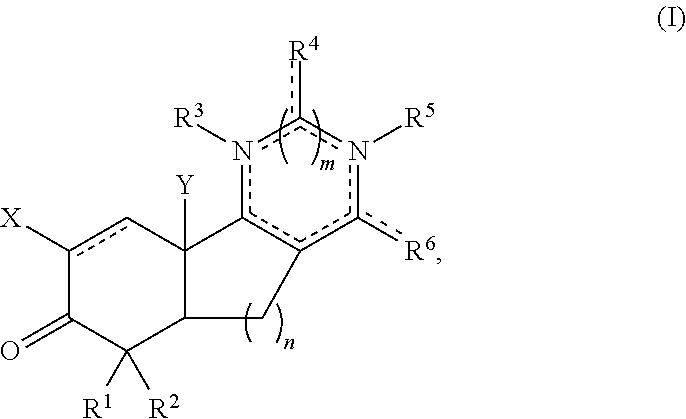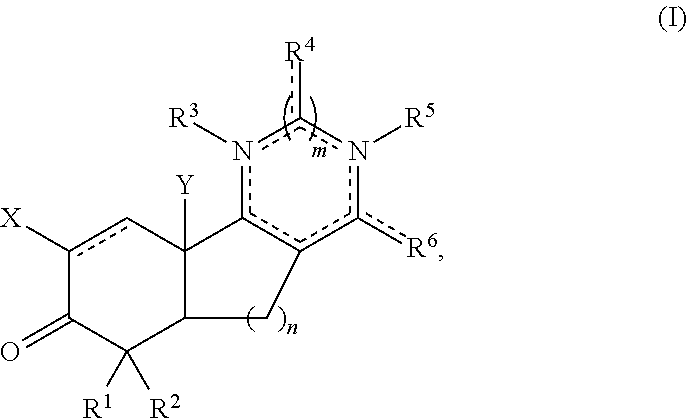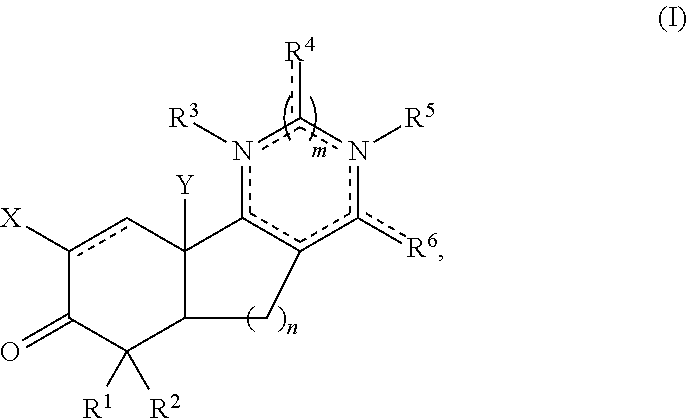Aryl and arylalkyl substituted pyrazolyl and pyrimidinyl tricyclic enones as antioxidant inflammation modulators
a technology of antioxidant inflammation and tricyclic enones, which is applied in the field of biochemistry and medicine, can solve the problems of high cost of production of highly purified triterpenoid starting materials, and the inability to ensure that the triterpenoid starting materials employed to date have optimal properties for all applications
- Summary
- Abstract
- Description
- Claims
- Application Information
AI Technical Summary
Benefits of technology
Problems solved by technology
Method used
Image
Examples
example 1
(6aS,7S,10aR)-7-methyl-8-oxo-10a-phenyl-5,6,6a,7,8,10a-hexahydrobenzo[h]quinazoline-9-carbonitrile
example 1a
2-phenylcyclohexane-1,3-dione
[0906]A 5 L round-bottomed flask was charged with bromobenzene (0.109 L, 1038 mmol), tert-amyl alcohol (1 L) and dioxane (2 L), and the contents were purged with N2 for 45 minutes. A 5 L round-bottomed flask was charged with potassium phosphate tribasic (459 g, 2163 mmol), 1,3-cyclohexanedione (100 g, 865 mmol), palladium(II) acetate (3.59 g, 16.00 mmol) and 2-(di-tert-butylphospino)-2′-methylbiphenyl (10 g, 32.0 mmol), and the contents were purged with N2 for 45 minutes. The bromobenzene solution was then transferred to 1,3-cyclohexanedione containing vessel via cannula, and the reaction was heated to reflux overnight. After cooling to room temperature, the reaction mixture was partitioned between ethyl acetate (2 L) and 10% HCl (3 L) with mixing. The lower aqueous layer was separated and extracted with ethyl acetate (2 L). The combined organic layers were washed with brine (1 L) and concentrated. The residue was taken up in toluene (1 L) and again conc...
example 1b
(8aR)-5-methyl-8a-phenyl-3,4,8,8a-tetrahydronaphthalene-1,6(2H,7H)-dione
[0907]A 5 L round-bottomed flask was charged with the product of Example 1A (163 g, 903 mmol) in acetonitrile (1.5 L). Triethylamine (252 mL, 1805 mmol) and ethyl vinyl ketone (135 mL, 1.35 mol) were added, and the contents were warmed to 75° C. and stirred overnight. After cooling, the reaction mixture was concentrated. The residue was taken up in dimethyl sulfoxide (500 mL). Pyridinium para-toluenesulfonate (227 g, 903 mmol) and L-phenylalanine (149 g, 903 mmol) were added, and the contents were warmed to 45° C. for 66 hours. After cooling, the reaction mixture was poured into saturated aqueous NH4Cl (500 mL), water (500 mL), and methyl tert-butyl ether (500 mL). After mixing for 10 minutes, the solids were removed by filtration and the layers separated. The aqueous layer was extracted with methyl tert-butyl ether (500 mL). The combined organic layers were washed with water (300 mL) and brine (300 mL), dried o...
PUM
| Property | Measurement | Unit |
|---|---|---|
| compositions | aaaaa | aaaaa |
| oxidative stress | aaaaa | aaaaa |
Abstract
Description
Claims
Application Information
 Login to View More
Login to View More - R&D
- Intellectual Property
- Life Sciences
- Materials
- Tech Scout
- Unparalleled Data Quality
- Higher Quality Content
- 60% Fewer Hallucinations
Browse by: Latest US Patents, China's latest patents, Technical Efficacy Thesaurus, Application Domain, Technology Topic, Popular Technical Reports.
© 2025 PatSnap. All rights reserved.Legal|Privacy policy|Modern Slavery Act Transparency Statement|Sitemap|About US| Contact US: help@patsnap.com



